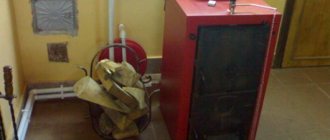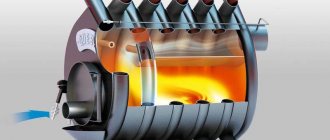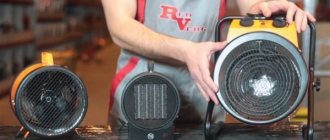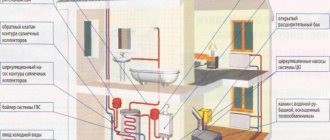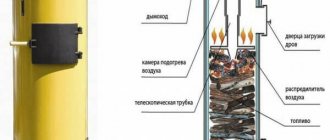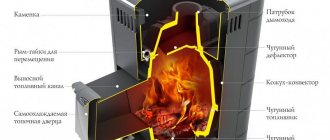Updated: 02/19/2021 18:37:14
Expert: Konstantin Borisovich Polyakov
*Review of the best according to the editors of expertology.ru. About the selection criteria. This material is subjective in nature, does not constitute advertising and does not serve as a purchase guide. Before purchasing, consultation with a specialist is required.
A garage helps protect your car from precipitation, as well as theft or vandalism. It does not matter whether it is heated or not. But when you need to tinker with the car, your fingers quickly freeze from contact with cold metal, and then the question of temporary heating arises. We have compiled a list of the best garage heaters based on performance analysis and owner reviews. This will help you buy a product for a specific area and other operating conditions, and also not regret the money spent.
Rating of the best heaters for garages 2021-2022
| Place | Name | Price | Rating |
| The best garage heaters by price/quality | |||
| 1 | Ballu BHDN-20 | Find out the price | 9.9 / 10 |
| 2 | RESANTA TEPK-2000K without burner | Find out the price | 9.8 / 10 |
| 3 | Electrolux EFH/W-7020 | Find out the price | 9.6 / 10 |
| The best heaters for a diesel garage | |||
| 1 | RESANTA TDP-20000 | Find out the price | 9.9 / 10 |
| 2 | Ballu BHDP-100 | Find out the price | 9.7 / 10 |
| 3 | Solarogas Savo PO-2.5 | Find out the price | 9.5 / 10 |
| The Best Gas Heaters for a Garage | |||
| 1 | Ballu BIGH-55 4.2 kW, 60 m² | Find out the price | 9.9 / 10 |
| 2 | RESANTA PG-4200B 4.2 kW, 60 m² | Find out the price | 9.8 / 10 |
| 3 | Aeroheat IG 2000 2.3 kW, 18 m² | Find out the price | 9.5 / 10 |
| The best electric fan heaters for the garage | |||
| 1 | RESANTA TVS-1 | Find out the price | 9.9 / 10 |
| 2 | Ballu BFH/S-10 | Find out the price | 9.7 / 10 |
| 3 | Zanussi ZFH/C-408 | Find out the price | 9.4 / 10 |
| The best infrared heaters for the garage | |||
| 1 | Ballu BHH/M-09N | Find out the price | 9.9 / 10 |
| 2 | RESANTA IKO-800L | Find out the price | 9.8 / 10 |
| 3 | Polaris PMN 1584 | Find out the price | 9.5 / 10 |
Thermal insulation is the key to heat preservation
Finally, I would like to draw the attention of garage owners to a factor that directly determines how quickly the garage will heat up and how long it will remain warm. This is insulation. For thermal insulation, experts recommend using one of the following materials:
- Basalt mineral wool
retains heat well. However, when wet, it loses its thermal insulation properties. - Glass wool
is cheap, but also does not tolerate moisture. Requires increased safety measures when working. - Polystyrene foam
is more tolerant of water. Lightweight, budget-friendly, durable material. Requires good ventilation in the room. - Also, polyurethane foam
, foil fabric, warm plaster and even insulating paint are often used for thermal insulation.
Choose the best option for a heater and insulation products, and let your garage always be warm and cozy!
How to choose a heater for a garage in terms of price/quality ratio?
When choosing a heater for your garage, you need to consider the following points:
- the device must be safe for a garage containing flammable substances;
- it must show a high level of efficiency;
- financial costs for heating should be kept to a minimum.
Some owners are comfortable being in a large garage using a device with minimal power for heating, but it is better to know that “the larger the garage, the greater the power of the heater.” There is a SNiP standard that states that the garage must be heated to a temperature of +5°C in the winter.
Kinds:
- Diesel and kerosene . This option is purchased by those who do not have an insulated garage. Diesel models do not require expensive fuel, but are highly efficient. They are small in size and easy to handle. For the garage, I advise you to pay attention to models with indirect heating, which are equipped with a pipe for exhausting gases. The device can operate uninterruptedly for 15 hours, but the room must be ventilated.
- Gas . The advantage of such devices is that they operate without electricity. Gas heaters are more expensive than electric heaters, but taking into account the prices of gas and electricity, this difference will soon pay off.
- There are two types of heaters on the market - convector and ceramic . The first heats up to 60°C, but the second is considered more economical, since due to the heating of the ceramic panel, which subsequently emits heat, it consumes less gas.
- Infrared heaters . It also requires an electrical connection to operate. The maximum effect during warming up can be achieved by hanging the device from the ceiling. Infrared models heat the room (the place where the radiation is directed) the fastest.
If the flame goes out, the heating equipment automatically turns off - one of the equipment protection modes is activated. However, the cost of a ceramic device is much higher than a convector one.
Classic. For a garage, they have one drawback - they require a constant connection to the network. The advantage is that there are a large number of models on the market with different price ranges.
Most often installed in the garage:
- wall convectors;
- oil radiators;
- fan heaters and curtains;
- heat guns.
The infrared heater does not make noise or smell during operation, and does not occupy a large area. If the height of the garage is no more than 2.5 meters, then low-temperature IR heaters are used for heating.
An infrared lamp has a local effect, heating only the object at which it is directed. In this case, you need to wait until the heated object begins to give off heat so that the entire garage warms up. Fortunately, modern models heat up quickly, so there are no problems.
For a large room, two or more than two lamps should be installed. The main thing is not to point them at flammable objects.
What you should pay attention to when choosing:
- Quality of material and automation . The material must be fireproof, and it is better to choose the simplest automation system. As soon as the air heats up, the device will automatically turn off or reduce the heating power.
- Efficiency and heat transfer . The efficiency of almost all electric heaters reaches 98%. It is important that the structure can evenly transfer heat to the surrounding space.
- Economical . Electric models are considered the most convenient to use and have a high level of efficiency, but they can mercilessly twist electricity. In this case, you need to make sure that everything spent is compensated by the heat given off. Many appliances are equipped with a thermostat that maintains a preset heat level.
- Mobility . If necessary, you can easily move the device.
- Type of construction: floor, wall, tabletop.
Let's sum it up
A garage heater is a must if you spend a lot of time there - in severe frosts you can easily freeze there without it. Thanks to the heaters, you will not experience any discomfort, even if you stay in the garage for hours.
It is not recommended to purchase the first option you come across - it is important to carefully select a heater so that it works effectively and its use is safe. It is worth deciding in advance how much power will be enough for you, as well as which option is more suitable for you - powered by electricity or using fuel. Our rating presents the best heaters of all known in 2022 - you can purchase any model, and it will definitely not disappoint you.
The best heaters for a diesel garage
RESANTA TDP-20000 (20 kW)
| Expert rating: ⭐ 9.9 / 10 | |
| Owner review | |
| We bought this gun when we were finishing renovations in the house. It was already autumn and the walls did not want to dry at all, but it was necessary to glue the wallpaper. With this gun we were able to dry everything in a week. The house is big. We donated this gun to our daughter for her dance. The rehearsal hall is huge and not heated. Turned it on for 30 minutes and it was warm. |
The diesel heat gun RESANTA TDP-20000 is used for heating large buildings and warehouses.
The heater runs on kerosene or diesel fuel.
For safe use, the model has two levels of protection:
- protection against flame extinction;
- ignition protection.
In 2021-2022, this model occupies a high place in the market ranking. It not only meets the stated safety requirements, but also has the longest service life among other models.
The heat gun is equipped with a capacious fuel tank, which can operate for a long time without refueling. Fuel consumption is 1.85 kg/h. The durable heater housing protects internal elements from mechanical damage.
The temperature mode of the heater can be controlled using a thermostat, the selected mode is maintained automatically.
There is protection against overheating.
Specifications:
- Fuel tank volume: 24 l.
- Heating area: 200 m2.
- Average fuel consumption: 1.58 kg/h.
- Maximum thermal power: 20 kW.
- Maximum productivity: 588 m3/h.
- Power supply: mains / diesel fuel.
- Overall dimensions L*W*H: 900*470*540.
- Weight: 18.8 kg.
pros
Economical energy consumption.
Instant heating of the room.
Two degrees of protection.
Minuses
No.
Ballu BHDP-100 (100 kW)
| Expert rating: ⭐ 9.7 / 10 | |
| Owner review | |
| This is a great option for our construction team. Helps out in wet weather, in cold weather, powerful, warms and dries rooms. Packed with a thermostat, it significantly saves diesel fuel and has a large temperature range. We have been working with it for more than one season until there are no noticeable signs of rust. With proper care and inspection it works flawlessly. |
A diesel gun is used for local heating of surfaces or heating of production and storage facilities . The structure is made of metal and has an anti-corrosion coating on the body.
The heater has a built-in thermostat with a high level of sensitivity, which allows you to select and maintain the optimal temperature level. A multi-level electronically controlled security system increases the service life of the device.
The model runs on diesel fuel and has a built-in sensor indicating the fuel level.
The heater's consumption is 9.9 l/h, the fuel tank volume has been increased - 68 l. Among all diesel heaters, Ballu BHDP-100 is the only one that achieves 100% efficiency.
Specifications:
- Fuel tank volume: 68 l.
- Effective for rooms up to: 1,000 m2.
- Average fuel consumption: 8.3 kg/h.
- Maximum productivity: 1,300 m3/h.
- Maximum thermal power: 100 kW.
- Maximum power consumption: 0.64 kW.
- Electrical connection: power cable with plug.
- Fuel type: diesel.
- Type of installation (mounting): floor.
- Power supply voltage: 220 V.
- Overall dimensions H*W*D: 0.705*1.215*0.505 m.
- Weight (net): 38.7 kg.
pros
Transformer ignition system 12 kV electronically controlled.
The flame control system is equipped with a photocell.
Built-in additional protection against flame cutting.
Air purification filter and coarse fuel filter.
Minuses
Short power cord.
High price range.
Solarogas Savo PO-2.5
| Expert rating: ⭐ 9.5 / 10 | |
| Owner review | |
| Heats well, high efficiency (efficiency), low consumption, you can cook food, requires minimal maintenance, simple as a stool, cheap, no need for gas cylinders. We have been using it for 7 years now. The order is the same. After the summer, disassemble, clean, reassemble, and you can continue to enjoy your work. The wicks were replaced once. So I recommend this oven. |
Solarogas Savo is a gas-type heater that is fueled with diesel or kerosene . Thanks to the high power of the stove, non-residential premises are heated in a few minutes.
The peculiarity of a modern heater lies in its autonomy of use, which does not depend on electricity. The device uses the principle of “afterburning residual products of fuel combustion” - this helps to avoid the appearance of an unpleasant odor.
The heater burner is made of stainless steel, which increases its service life.
The power of the furnace is 2.5 kW; it heats up an area of 50 m³ in two hours.
A fully charged tank ensures uninterrupted operation of the heater for 14 hours.
To reduce smoking and increase power during operation, it is necessary to use more than two special wicks.
Specifications:
- Fuel tank volume: 3.2 l.
- Burning time of one filling: 14-18 hours.
- Fuel consumption: 0.2 l/h.
- Maximum thermal power: 2.5 kW.
- Fuel: kerosene, diesel (diesel).
- Dimensions H*W*D: 370*420*320 mm.
- Weight: 5.6 kg.
pros
The package includes three special wicks.
No expensive fuel required.
Requires minimal maintenance.
Affordable price range.
Minuses
Do not use indoors - unpleasant odor may appear.
Great inertia.
Use of general heating
The ideal situation is when the garage is located next to a private house or a public heating pipe. You can route the heating main into it. In the case of a city, everything is done through the appropriate services. In relation to home, it’s simpler - you need several radiators, connecting pipes and insulation for laying a heating main along the street. In the case of a private option, the central hot water supply line from the boiler is disconnected, into which an additional heating branch is built, as if extending it. Below are two options for inserting into the heating network of a house, depending on its type.
When connecting a garage to a citywide network, the connection is made by tapping (without breaking it!) into the hot water supply and return line. In general, it is better to entrust such a procedure for a municipal heating system to specialized organizations. It will not be much more expensive than the design of the insertion project itself, carrying out work on it and other nuances of execution.
Which company should you choose?
There is a large selection of equipment models and manufacturers on the market, including:
- RESANTA is a leader in the welding inverter market. The company presents a large selection of heating equipment: from household devices to devices that are in demand in production and warehouse facilities.
- Ballu is a company that provides climate control equipment. In its work technology, using environmentally friendly materials. Manufactured products meet not only Russian, but also international quality standards.
- Electrolux is a Swedish manufacturer of household and professional appliances. Heating equipment is manufactured using an inverter heating system, which saves energy.
- Solarogaz is a Russian manufacturer based in Penza. It has been manufacturing diesel and gas heaters for more than 20 years.
- Aeroheat is a manufacturer of heating equipment that creates modern products that meet not only quality standards, but also follow new trends (from a technical and design perspective). The company's equipment has wide functionality, advanced technical characteristics and guarantees a high level of comfort.
- Zanussi is an Italian company producing household and heating appliances. The price range of equipment is from economy to middle class. The company has been one of the world leaders in the production of household appliances since 1994.
- Polaris is a Swiss brand, developed by European engineers. Every year the company presents innovative solutions that expand the capabilities and functions of equipment. Polaris heaters are in great demand in many countries around the world.
Power supply
Gas heater
Most permanent garages are connected to electrical networks, which provides not only lighting, but also the ability to connect electrical appliances. Less common are garage cooperatives where there is a water supply and sewerage.
There are practically no garages with centralized gas supply. Such features limit the possibilities of heating the room. The owner can choose:
- liquid hydrocarbons;
- solid fuel;
- electricity.
Which is better, everyone must decide for themselves.
Making a stand
The stand is made from a metal corner or profile. Dimensions are set based on the overall size of the heater. To make it you will need a welding machine and an electric grinder – “grinder”. From a corner or profile we cut the elements of the future stand. Its shape is also arbitrary. It is only necessary to take into account such a point as the ease of disassembling it. It is quite possible that it will be necessary to disassemble the heater. For example, in the spring, when it is no longer needed.
Before you start making the stand, you need to draw its diagram, determine the dimensions and prepare the blanks.
To do this, use a grinder to carefully cut the required number of corners and sand their edges. All that remains is to “cook” the pieces cut according to the pattern. After welding, the seams are cleaned and the stand is prepared for painting.
Practical implementation of heating a garage using an electric boiler
At the very beginning, when heating the garage with electricity, you need to choose the installation location for the boiler and radiators. The space should be as open as possible and not interfere with the use of the garage equipment itself, including opening the car doors, or raising its trunk and hood. Next comes the selection of a heating device in the store. Even for a garage of 20 m², a boiler of 1 kW and the cheapest pump will be enough, as long as it can connect and withstand the circulation of hot water through pipes with an internal diameter of 15–20 mm, which will be used to connect the entire system. Plus, you will need an expansion tank and the radiator itself.
Of the specific recommendations, the electric boiler “Economy EVP-3 KW”, costing only 1800 rubles, looks good in this regard. Don't look at large kilowatt/hour values. It doesn't constantly spin electricity. The principle is this: the boiler heats the liquid in the system to the set maximum temperature. Turns off. As long as the heat exchanger is cooled within certain limits, it does not react. As soon as the degrees fall below the bar, it is activated and again raises the temperature of the liquid.
You don’t have to worry about choosing a specific pump either. All circulation options with a consumption of up to or equal to 100 W, located in the price range from 1500 to 2000 rubles, are suitable.
An expansion tank is absolutely necessary so that the system does not fall apart at one nasty moment. You can come up with it yourself - it’s just a container attached to a hot water exchange system. Its main function manifests itself when the liquid expands as a result of heating - the excess goes into this tank. It is better and easier to buy ready-made solutions for such a vessel, equipped with the necessary pipes and adapters. A 2 liter model is quite enough. For example, from the company LadAna, for less than 500 rubles. As for the pipes themselves, it is better to use metal versions or heat-resistant plastic.
If there is no opportunity or desire to buy radiators, then use a homemade bundle of pipes. There is only one principle here - that the maximum amount of hot water be distributed over a larger surface. Although there are neat industrial heat exchangers on sale. They are mainly made of segment modules. A couple of such assemblies, each one meter long, will fully meet the needs of the average garage.
The boiler itself must be connected to the power line through thick copper wires and good circuit breakers at phase and zero, with limits of 25 A. In parallel, a pump is also connected to the power supply. Another nuance related to connecting the latter, but concerning water, they try to put it on the reverse of the system. This is done so that it works at lower fluid temperatures and does not overheat. One more thing. Without a separately removed and mounted “ground” in addition to the “zero”, such powerful equipment simply cannot be used, this applies to both the boiler and the pump.
